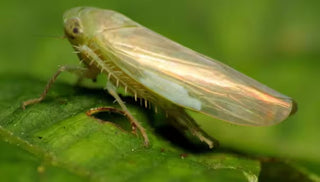Stunted growth or leaves that are curled, stippled, or have a burned appearance are signs of leafhopper damage. The adults and nymphs pierce foliage and suck out plant juices. Their toxic saliva produces the characteristic damage symptoms and also transmits viral diseases. In vegetable gardens, leafhoppers seem to prefer potatoes, beans, lettuce, peppers and beets.
The small, streamlined insects hop when disturbed, and may be green, brown, or yellow in color; some species are striped. Adult leafhoppers overwinter in plant debris near the garden and some also migrate north from warmer zones during the growing season. They lay eggs on the leaves of host plants and the nymphs feed on the underside of leaves. There are usually two or more generations each year. Leafhoppers are found throughout North America.
Prevention and Control
- Place garden fabric over susceptible plants to protect them from leafhopper damage. Check occasionally to be sure that no leafhoppers have emerged from the soil under the covers.
- Leaf hoppers can also be dislodged from plants with a strong spray of water from your hose. Recheck the plants a few days later and repeat the treatment as many times as needed. (Keep in mind that a blast of water can also kill beneficial insects.)
- Encourage predatory flies and parasitic wasps that prey on leafhoppers.
- Remove weeds and debris from the garden in fall to reduce the number of overwintering leafhoppers.


 Leafhopper burn to leaf of green ti (Cordyline fruticosa) Photo:
Leafhopper burn to leaf of green ti (Cordyline fruticosa) Photo: Leafhopper
Leafhopper

